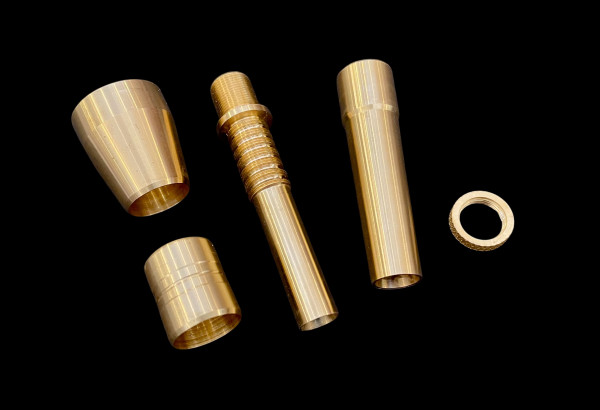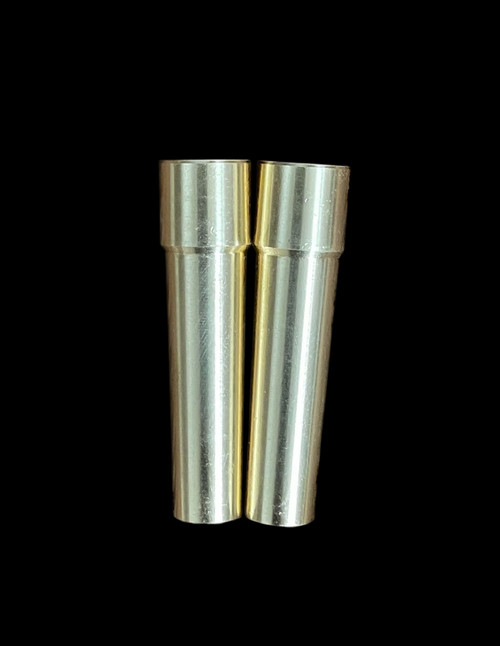Product Overview
Variable Length Trumpet Backbore
Backbore length has a significant influence on how a mouthpiece slots. Mostly noticeably it changes the pitch of the fifth partial, affecting the tuning of the 4th space E and the cluster of notes associated with it, especially the Eb and D. All of these notes tend to be flat on Bb trumpets and worse on C or higher pitched trumpets. This is why many manufactures now offer shorter backbores, especially popular for C trumpet, but they are also used on Bb horns.
The relative pitch between notes is also influenced by cup depth. As a result, some manufacturers vary the length of the backbore to balance the cup depth, with deeper cups having short backbore lengths.
One of the problems with raising the pitch of the 5th partial with a shorter backbore is that the change in slotting can bleed into the 6th partial, driving the top of staff G sharp if the backbore is too short or not balanced with the cup. This can be a big problem. We can control a flat E by lipping it up to some extent, or by using alternate fingerings, but a sharp G is very hard to adjust unless you have a built in pitch finder on your main slide.
But what if you could fine tune length of your backbore to select the optimal pitch of the 5th partial without making the G go too sharp? Well, now you can.
The Wedge adjustable backbore lets you literally dial in the backbore length from slightly longer than a normal Bb backbore to shorter than most C length backbores with an infinite number of available lengths.
The backbore consists of a central core which determines the backbore size ranging from small to large.
The shank of the backbores threads up the central core and can be locked in place with a knurled collar at reproducible reference points provided by breaks in the thread pattern.
You simply adjust the backbore length while testing the overall pitch and slotting, paying special attention to problematic notes for your particular horn and cup depth (usually the 4th space E and top of staff G) until you find the best balance.
The adjustable mechanism is then be covered with a regular weight or heavy weight sleeve that threads over it from above before attaching the mouthpiece top.
Sizes: These backbores are being introduced in our regular Small, Medium, ML and L sizes witb either a 27 or 25 throat. Note that the VLB when used at the shortest length feels tighter than a one piece C length backbore. If you intend to use the VLB mostly at the shorter lenght consider going one size laerger than your preferred one piece backbore.
Small Backbore - This size works best with shallow tops such as our ES, LV, and S cups. It produces good support in the upper register and a focussed sound without being overly restrictive. It is a bit bigger than a Schilke A backbore and similar to a Warburton 4 or 5, or a Pickett 10-4 backbore.
Medium Backbore - This size works well with MV and MDV cups. It is a good all round backbore with a balance between low register resonance and upper register support. It similar to a Warburton 6 or 7, or Pickett 10-3.
Medium Large Backbore - The ML backbore is most popular for our MDV and RT tops, but also works well with MV tops. It produces a slightly broader sound than the M backbore with a bit less support in the upper register. It is the best choice for orchestral playing. It is similar to a Bach 10 or Warburton 8 or 10 backbore, or a Pickett 10-2.
Large Backbore - One step larger than the ML, suitable for MDV and RT cups when a broader sound is desired.
Sleeve Options: Heavy sleeves dampen the brighter overtones slightly and improve slotting. They are designed for use with Wedge tops.
The regular sleeve works with Wedge tops and tops for most other manufactures (Warburton, ACB, Pickett) using the standard 3/8-40 thread.
Shank Sizes: The standard VLB shank has the same OD as our standard mouthpieces and backbores, which is 0.385 inches. This is the same OD as most other manufacturers, recognizing that there is often a variation of +/- 0.001 inches when one measures actual specimens from any maker.
We also offer Variable Gap Shanks
Sizes (OD of the shank tip in inches):
1 - 0.397 - Largest Shank and Largest Gap
2 - 0.394
3 - 0.391
4 - 0.388
5 - 0.385 - Standard Shank
6 - 0.382
7 - 0.379 - Smallest Shank and Smallest Gap
Shanks can be ordered separately or in sets of three at a 10% discount.
The combination of an adjustble backbore length and mouthpiece gap provides the ultimate ability to fine tune the performance of your backbore with a specific horn and cup combination.















